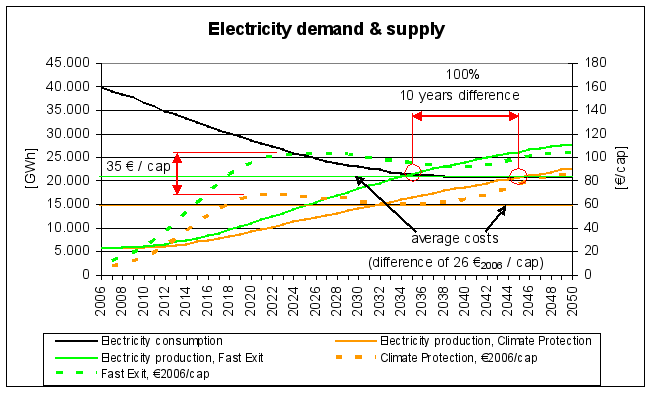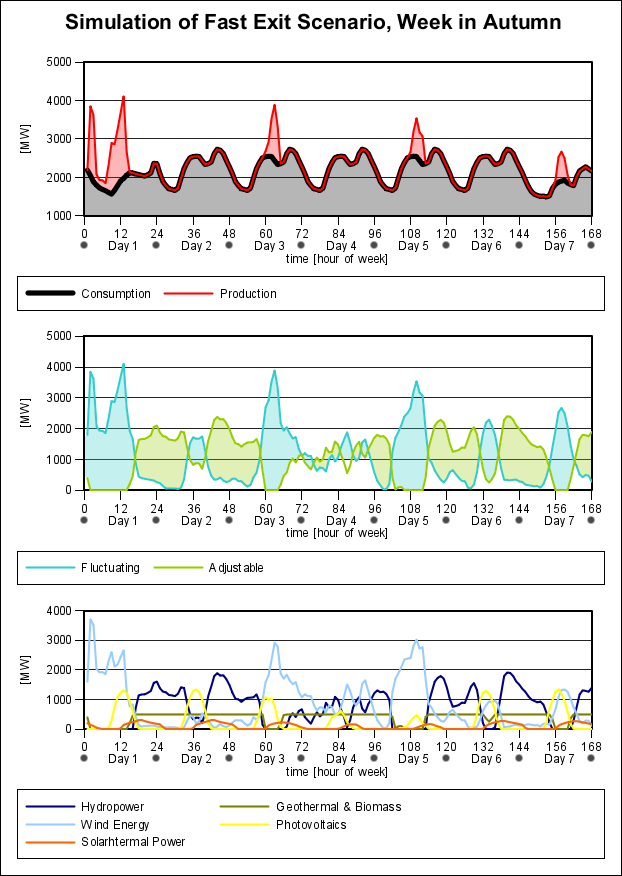Catalunya
Solar Catalonia
A Pathway to a 100% Renewable Energy System for Catalonia
Authors: Stefan Peter (iSuSI), A. Doleschek (iSuSI), H. Lehmann (WCRE), J. Mirales(fundacio terra),
J. Puig (Eurosolar), J. Corominas (Ecoserveis), M. Garcia (Ecoserveis)
Summary
The objective of initiating this study is to show that a Catalonia is able to supply its own need for energy from renewable sources. Giving such a fact-based vision of a future energy supply is very important to influence the discussion about the change from fossil/nuclear energy sources towards a sustainable energy system, especially, as the ongoing discussion regarding the possibilities of renewable energy and efficient design has been negatively influenced by a lack of facts about the availability and potential of these technologies.
The goal of the project is to show that a sustainable renewable and efficient energy system is able to supply Catalonia’s current needs. This entails that the study does not consider any major changes in lifestyle and that the reductions in energy demand does neither cause any changes in living standard, nor do they assume any demographic changes. Consequently there
are no assumptions regarding the future economic development in terms of Gross Domestic Product or the like.
Although Catalonia showed a strong economic growth within the past ten years, Catalonia did not perform well with regard to energy intensity. It is quite clear that energy intensity in the Catalonian economy must be reduced in order to shift to a sustainable energy supply and to make it’s own contribution to climate protection. The scenarios within this work highlight a development towards halving electricity intensity in the three most important sectors of electricity consumption until 2050. This, of course, means making great efforts to improve the efficiency of electricity use, but we are convinced that this is feasible from a technological point of view. Further technological development towards more efficient appliances will assist such a development and restructuring our economies and redefining the relationship between energy consumption and wealth may be necessary but, in the end, climate change and it’s serious consequences will force us to walk this way. After all one fact is quite clear: we have to start now in order to keep transition smooth and to avoid the most serious consequences of climate change.
Taking the development as proposed here will bring down Catalonia’s electricity consumption to the 1993 level until 2025 and to the half of 2003’s electricity consumption by 2050. Even with respect to the facts, that further reductions will be harder to achieve the further we step into future and that a certain level of energy intensity will remain, the developments presented here show two remarkable facts: although getting energy intensity down to the half sounds very hard, half of the way solely consist of revoking the increase in energy intensity from 1993 to 2003. The remaining effort in efficiency improvements (compared to the efficiency Catalonia already had in 1993) is not of an extend that should make us doubt that this goal can be achieved.
Both scenarios show the feasibility to achieve a fully renewable supply, one until 2035 (Fast Exit Scenario), the other until 2045. This is not a matter of potentials, but it is a matter of setting and pursuing ambitious goals, encouraging policy and people and – of course – the financial investments Catalonia and it’s people are willing to take. The scenarios show that the financial aspect is not that big obstacle that one might expect. With an annual investment into renewable capacities peaking at 104 €2006 per inhabitant in the “Fast Exit Scenario” (2050) and 85€2006 / cap in the “Climate Protection Scenario”, the financial burden to achieve a clean a climate friendly electricity supply in Catalonia is moderate in our point of view; in 2030 investments are 103 €2006 / cap in the “Fast Exit Scenario” and 68 €2006 / cap in the “Climate Protection Scenario” (see Figure 1).
 |
Figure 1: Development of electricity demand and supply in the scenarios
These financial figures are only the peak investments during the whole development considered here. Calculating the average annual payments for the two different scenarios result to 58 €2006 per inhabitant and year in the “Climate Protection Scenario” and 84 €2006 per inhabitant and year in the “Fast Exit Scenario”.
Compared to the Catalonian Gross Domestic Product (181,029 million € in 2005) the annual costs of the scenarios are 0.2 % of the GDP for the “Climate Protection Scenario” and 0.3 % for the “Fast Exit Scenario” on average.
Any energy supply system must guarantee sufficient production and distribution of electricity, heat and fuels to meet the demand for energy at any time throughout the year, usually using different energy conversion technologies. Energy is supplied in the form of electricity, heat or fuels, with heat and fuels having the advantage that both can be stored for later use and can be easily transported. So it is not necessary to consume heat and fuels immediately or directly at the production site. Heat can be stored in thermal reservoirs and distributed via district heating networks. In contrast to heat and fuels, which dissipate with time - thus setting a limit to storage time and distribution distance -, fuels from biomass or hydrogen does not have this limitation in storage time or in transport (depending on the fuel type - solid, liquid or gaseous), but storage losses must be considered too.
The situation is completely different with electricity. The necessity of producing enough electricity, on demand and on time, makes this type of energy the most critical component in an energy supply system. While electrical transport via the public grid is quite unproblematic, storing electricity directly on a large scale is material- and cost- intensive. However, storage in batteries and accumulators can involve the use of toxic substances. Therefore this option is not considered here as it is not appropriate for a sustainable energy supply system. Indirect storage can be used, e.g. pumped hydro-storage systems.
An energy supply system which is based almost completely on renewable sources increases the focus on timely energy provision due to the fluctuating nature of some renewable energy sources, such as solar and wind. Including such fluctuating sources into the public electricity supply means that the power produced by those sources might decrease relatively fast. Of course electricity production from fluctuating sources can be estimated by weather forecasting but a portion of uncertainty still remains. Fortunately, there are other renewable technologies with the ability to deliver energy on demand; hydropower and geothermal power plants give direct access to renewable sources, cogeneration and other energy sources can use fuel from renewable sources (e.g. hydrogen or biomass).
The challenge in designing a highly renewable electricity supply system (up to 100% renewables) is to find the combination where advantages of each renewable source sum up to a functioning and reliable system, while disadvantages are balanced out. Especially in the electrical system the need for reserve capacities, necessary as a back up for fluctuating sources, can be minimised by choosing the right combination of renewable technologies to minimise fluctuations and the introduction of demand management to get a better alignment between production and demand.
In this study we only studied the dynamical behaviour of the electrical system in the scenario “Fast exit”. This was done without optimising the electrical energy system. This simulation was done for 4 typical weeks (spring, summer, autumn and winter), with typical weather of the year 2006 [MeteoCat; 2006]11. The optimization of the supply system and the introduction of modern electrical grid management methods (e.g. Demand Management) will be investigated in a later study.
Taking the four simulated weeks as representative for all the four seasons of the year, the supply system according to the “Fast Exit” scenario is capable of supplying all the electricity demand in Catalonia. Generally solar- and wind performance are substantially better during spring and summer than they are in autumn and winter. Due to the strong spring and summer performance of fluctuating suppliers (solar and wind) it is often the case that photovoltaics, solar thermal power and wind energy can supply by far more than the total electricity demand.
During the winter half year the adjustable suppliers are predominant in supply, as the decrease in solar radiation appears in conjunction with generally lower wind speeds. Looking at the big picture the climate variation over the year, with strong solar and wind performance during the warm periods over the year, favours a system as described here, as the adjustable suppliers (hydropower, geothermal and biomass) have to contribute most during those times when they can be operated in the best way. While a high utilisation of hydropower coincides with higher precipitation levels, geothermal- and biomass plants can mainly be operated during times with a higher demand for heat, thus giving the opportunity to take advantage of high efficient combined heat and power plants.
 |
Figure 2: Results of the simulation for one week in autumn
For downloading the full text please visit iSuSI
